Chart Color Schemes
est. as @ -- *
ABS ERP | -- people | --
2021 Census | -- people
Sales Activity
Curious about local property values? Filter the chart to assess the volume and appreciation (including resales) trends and regional comparisons, or scroll to the map below view this information at an individual property level.
Find a Recent Sale
Sales Detail
Population
Hay has shown very soft population growth performance across periods assessed by AreaSearch
Based on AreaSearch's analysis, Hay's population is around 2,926 as of Aug 2025. This reflects an increase of 29 people since the 2021 Census, which reported a population of 2,897 people. The change is inferred from the estimated resident population of 2,880 from the ABS as of June 2024 and an additional 36 validated new addresses since the Census date. This level of population equates to a density ratio of 0.20 persons per square kilometer. Population growth was primarily driven by overseas migration during recent periods.
AreaSearch is adopting ABS/Geoscience Australia projections for each SA2 area, as released in 2024 with 2022 as the base year. For areas not covered, AreaSearch utilises NSW State Government's SA2 level projections, released in 2022 with 2021 as the base year. Growth rates by age group are applied to all areas for years 2032 to 2041. Projections indicate a decline in overall population by 281 persons by 2041. However, growth is anticipated in specific age cohorts, led by the 75 to 84 age group with an increase of 61 people.
Frequently Asked Questions - Population
Development
The level of residential development activity in Hay is very low in comparison to the average area assessed nationally by AreaSearch
Hay has recorded approximately four residential properties granted approval per year. Over the past five financial years, from FY21 to FY25, 23 homes were approved, with two more approved so far in FY26. Despite a falling population during this period, housing supply has remained adequate relative to demand, resulting in a well-balanced market with good buyer choice.
The average expected construction cost value of new dwellings is $896,000, indicating that developers are targeting the premium market segment with higher-end properties. This year, $19.1 million in commercial development approvals have been recorded, demonstrating moderate levels of commercial development compared to other areas. Hay shows substantially reduced construction activity, 63.0% below the regional average per person, which generally supports stronger demand and values for established homes. However, construction activity has intensified recently. Nationally, this activity is also lower than the national average, reflecting market maturity and possible development constraints.
All new construction in the area consists of standalone homes, preserving Hay's low density nature and attracting space-seeking buyers. With an estimated 477 people per dwelling approval, Hay's development environment is quiet and low-activity. Given that population is expected to remain stable or decline, housing pressure should be reduced, potentially creating opportunities for buyers in the area.
Frequently Asked Questions - Development
Infrastructure
Hay has moderate levels of nearby infrastructure activity, ranking in the 41stth percentile nationally
Changes to local infrastructure significantly influence an area's performance. AreaSearch has identified 15 projects that are likely to impact the area. Key projects include John Houston Memorial Pool Upgrade, Hay Structure Plan, Hay Health Services Redevelopment, and Bishops Lodge Affordable Housing Development. The following list details those most relevant:.
Professional plan users can use the search below to filter and access additional projects.
INFRASTRUCTURE SEARCH
 Denotes AI-based impression for illustrative purposes only, not to be taken as definitive under any circumstances. Please follow links and conduct other investigations from the project's source for actual imagery. Developers and project owners wishing us to use original imagery please Contact Us and we will do so.
Denotes AI-based impression for illustrative purposes only, not to be taken as definitive under any circumstances. Please follow links and conduct other investigations from the project's source for actual imagery. Developers and project owners wishing us to use original imagery please Contact Us and we will do so.
Frequently Asked Questions - Infrastructure
South West Renewable Energy Zone
The South West Renewable Energy Zone (REZ) in NSW is one of five declared REZs under the Electricity Infrastructure Roadmap. Declared in April 2024, access rights were granted to successful projects in April 2025. The REZ is now in delivery phase, with construction underway on EnergyConnect (interstate transmission link, expected completion 2027) and early works progressing on VNI West. Four initial generation and storage projects (totalling ~3.56 GW generation and >700 MW storage) have secured access rights and are advancing toward financial close and construction in 2026-2028. The REZ will ultimately support up to 5.5 GW of new renewable capacity.
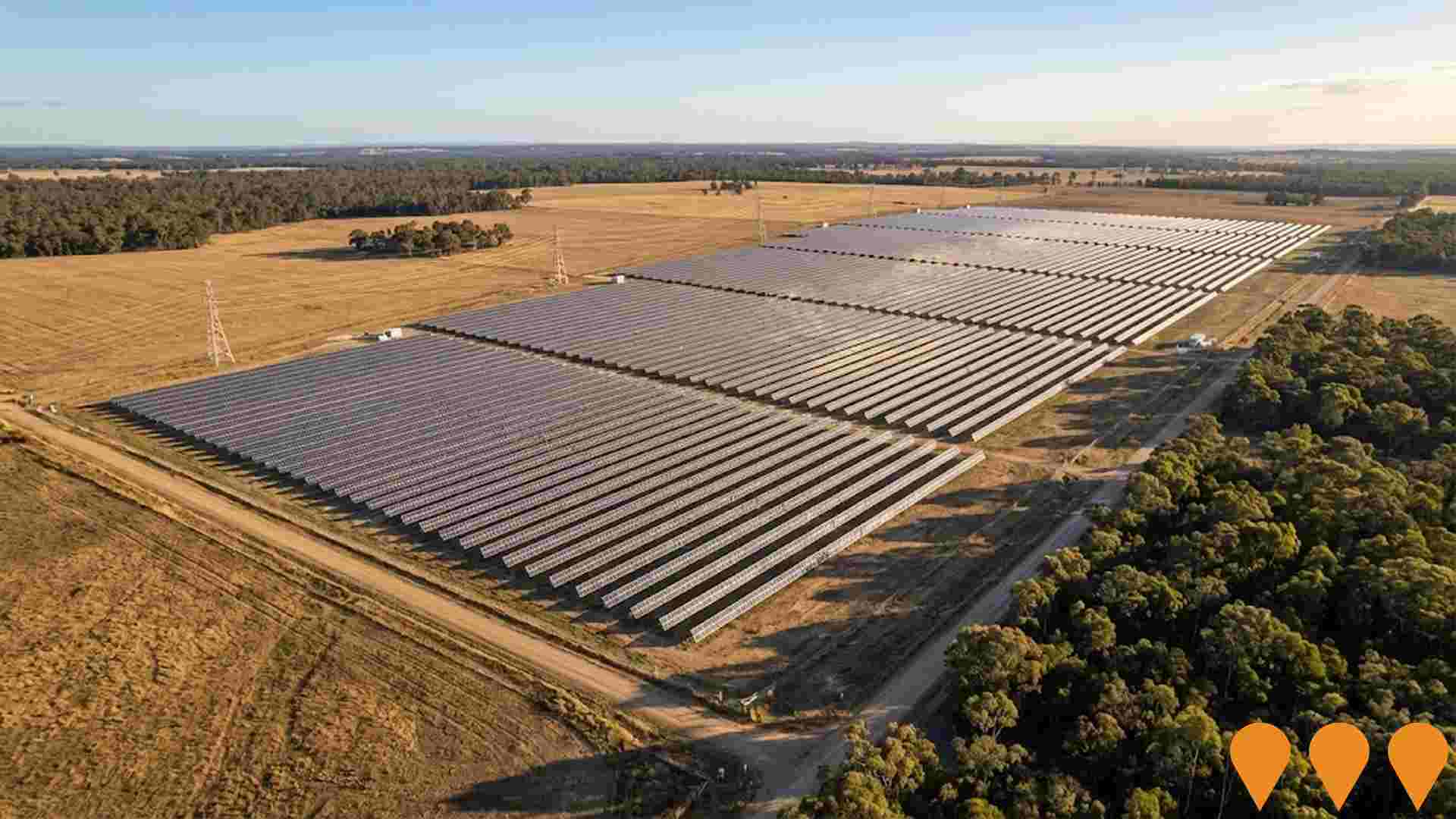
Bullawah Wind Farm
The Bullawah Wind Farm is a proposed large-scale renewable energy project by BayWa r.e. Projects Australia, located approximately 40km southeast of Hay in NSW's South West Renewable Energy Zone. The current layout includes up to 143 wind turbines with a generating capacity of ~1,000 MW and an integrated Battery Energy Storage System (BESS) of ~359 MW / 718 MWh. The project will connect to the Project EnergyConnect transmission line. The Environmental Impact Statement was exhibited in 2024, Response to Submissions completed in 2025, and in April 2025 the project secured access rights in the competitive South West REZ process. As of November 2025, the project remains under assessment with 'More Information Required' status at the NSW Planning Portal.
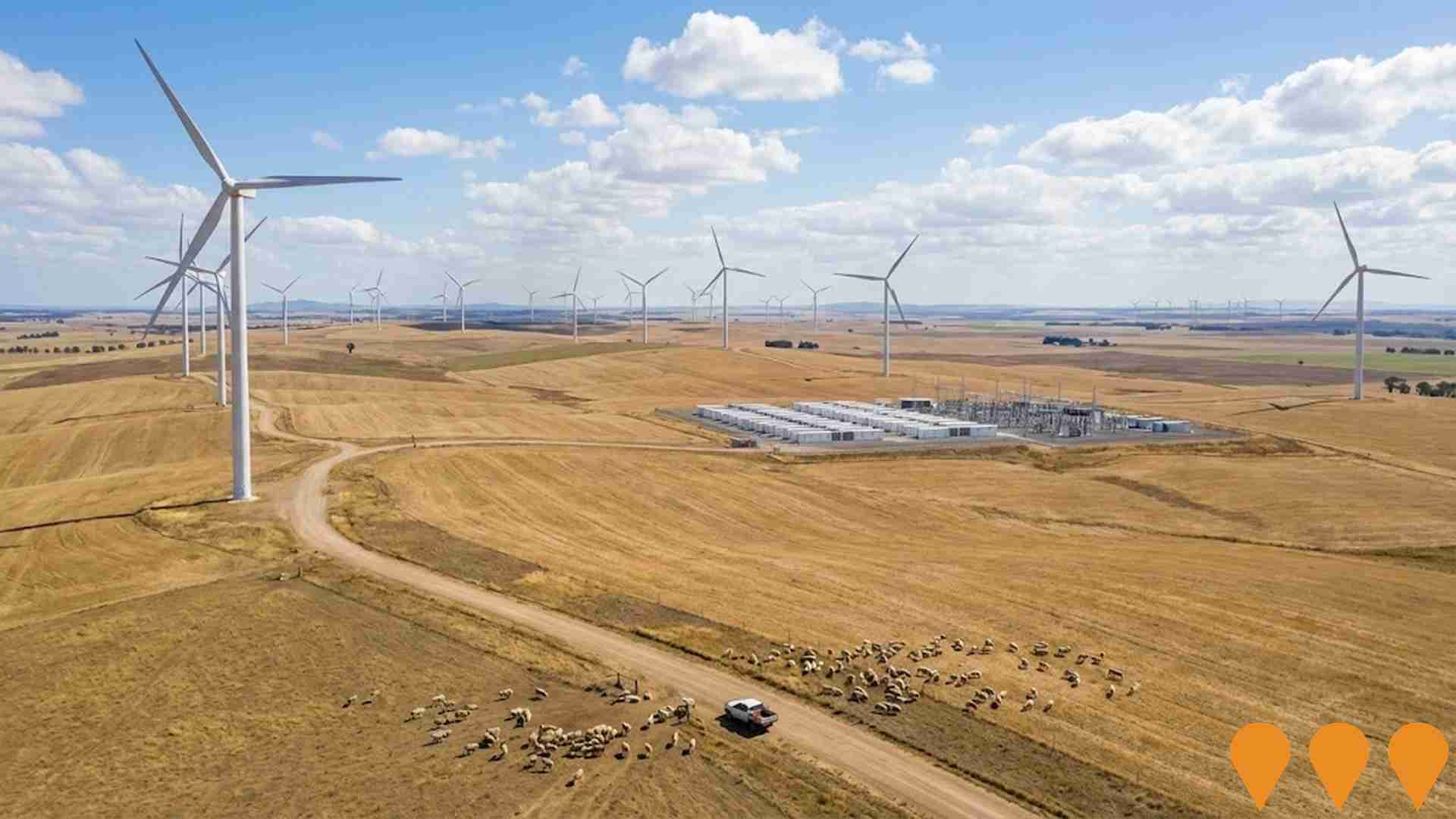
Baldon Wind Farm
Baldon Wind Farm is a proposed renewable energy project located approximately 15 km north of Moulamein in the South West Renewable Energy Zone, NSW. Developed by Goldwind Australia (in partnership with Omni Energy), the project includes up to 180 wind turbines with a total generation capacity of up to ~1,000-1,400 MW and an integrated 200 MW / 400-800 MWh battery energy storage system (BESS). The wind farm will connect to the National Electricity Market and is capable of powering over 700,000 average NSW homes. The Environmental Impact Statement (EIS) was exhibited in 2024, with a Response to Submissions lodged as part of the ongoing NSW planning assessment process.

VNI West (NSW section)
NSW portion of the VNI West interconnector: a proposed 500 kV double-circuit transmission line linking Transgrid's Dinawan Substation (near Coleambally) to the NSW/Victoria border north of Kerang, with associated upgrades including works on Transmission Line 51 near Wagga Wagga and expansion works at Dinawan Substation. The NSW Environmental Impact Statement (EIS) is on public exhibition in August 2025, and Transgrid has announced staged delivery with Stage 1 to Dinawan/South West REZ by early 2029 and Stage 2 to the Victorian border aligned to November 2030.
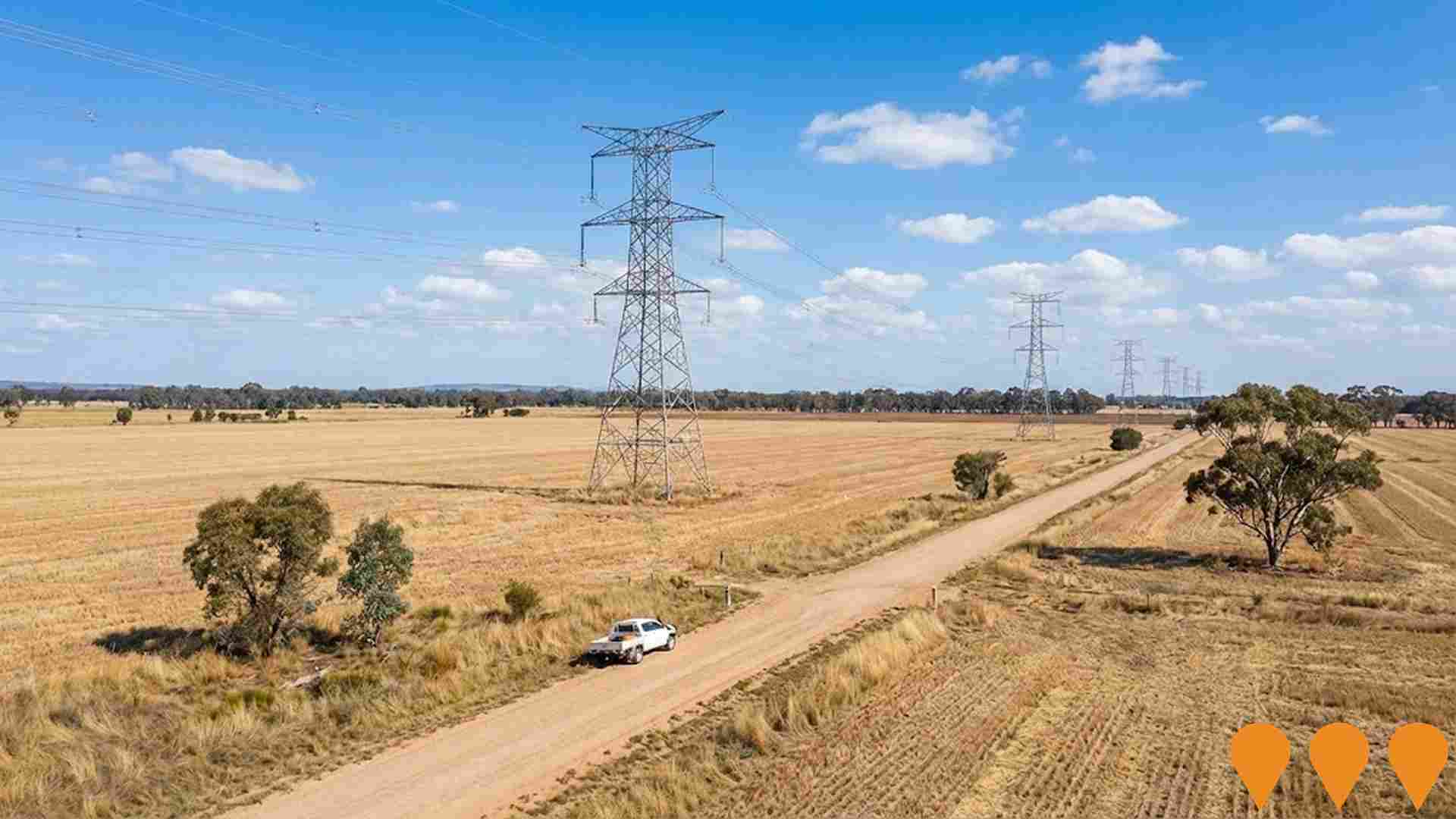
Saltbush Wind Farm
Proposed onshore wind farm in the South West Renewable Energy Zone near Booroorban, NSW. The project is targeting about 400 MW of wind capacity with up to 70 turbines (tip height up to 280 m), a battery energy storage system, substation and associated cabling. It is currently preparing an Environmental Impact Statement.
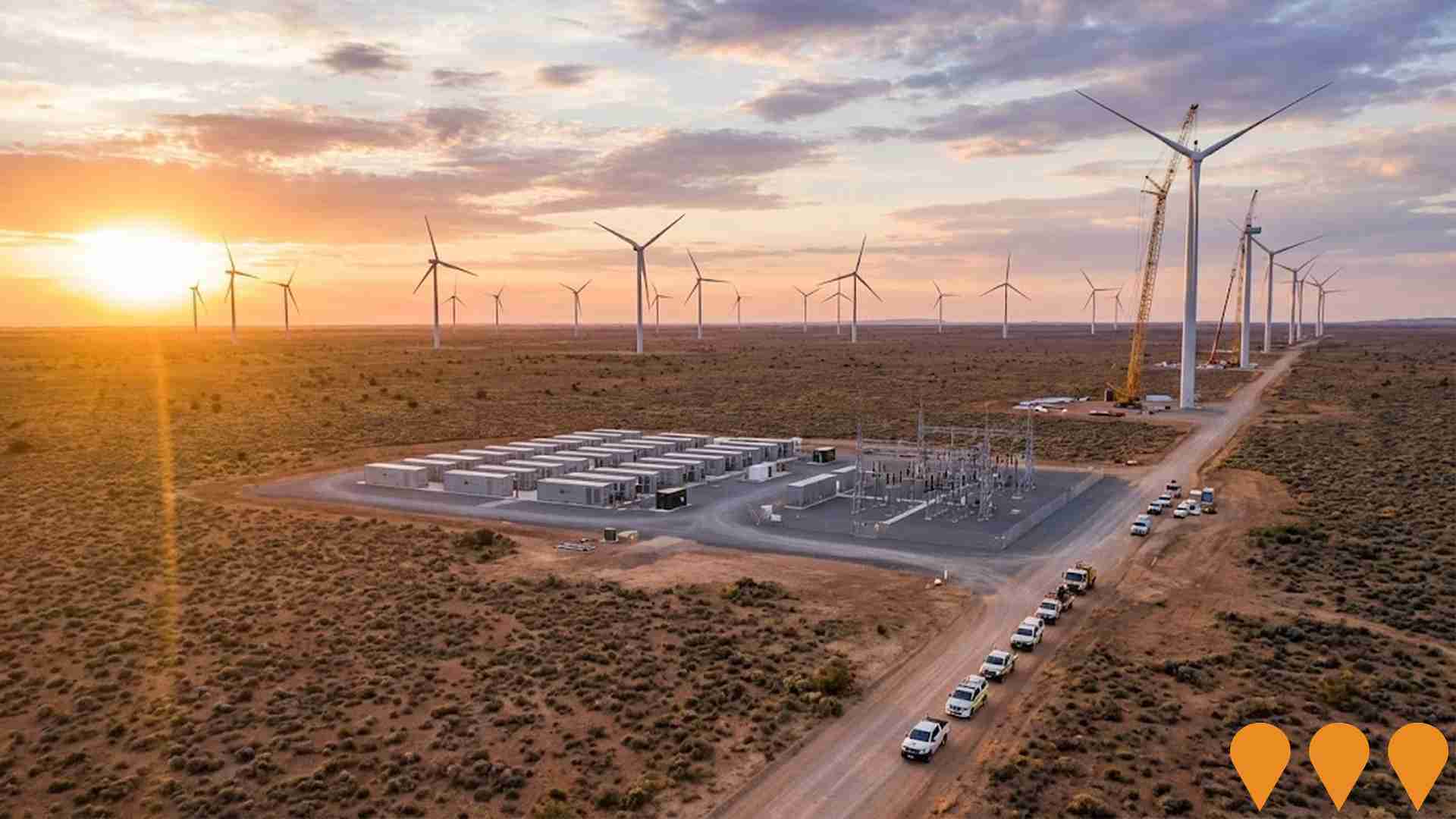
Tchelery Wind Farm
Neoen Australia is proposing a wind and battery project in the NSW South-West Renewable Energy Zone near Moulamein. The current concept is up to 577 MW from as many as 74 turbines, plus a 350 MW/1450 MWh battery. The project would connect to either the existing 220 kV line or the new Project EnergyConnect transmission line. The Development Application and Environmental Impact Statement have been lodged and publicly exhibited, and the project is now in the Response to Submissions stage with NSW planning authorities.
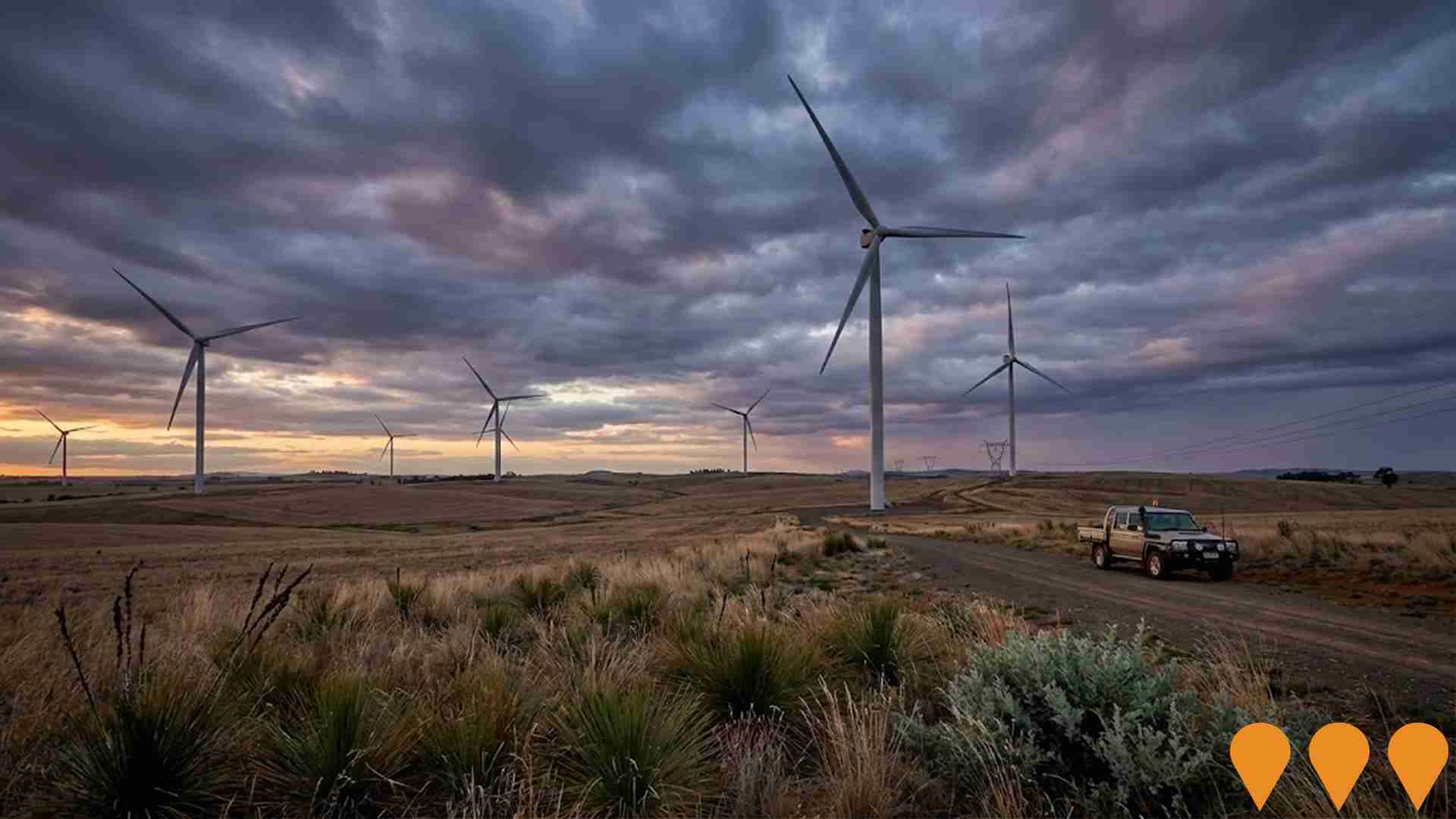
Coleambally Irrigation Water Savings Program (RRWIP)
Proposed water efficiency works across the Coleambally Irrigation Area under the Resilient Rivers Water Infrastructure Program. Scope includes around 4.7 km of new pipeline, three new regulating structures and re-lining about 12 km of earthen channels to reduce seepage and evaporation. The program targets improved delivery performance, drought resilience and approximately 1 GL of conveyance water savings for environmental outcomes and network efficiency.
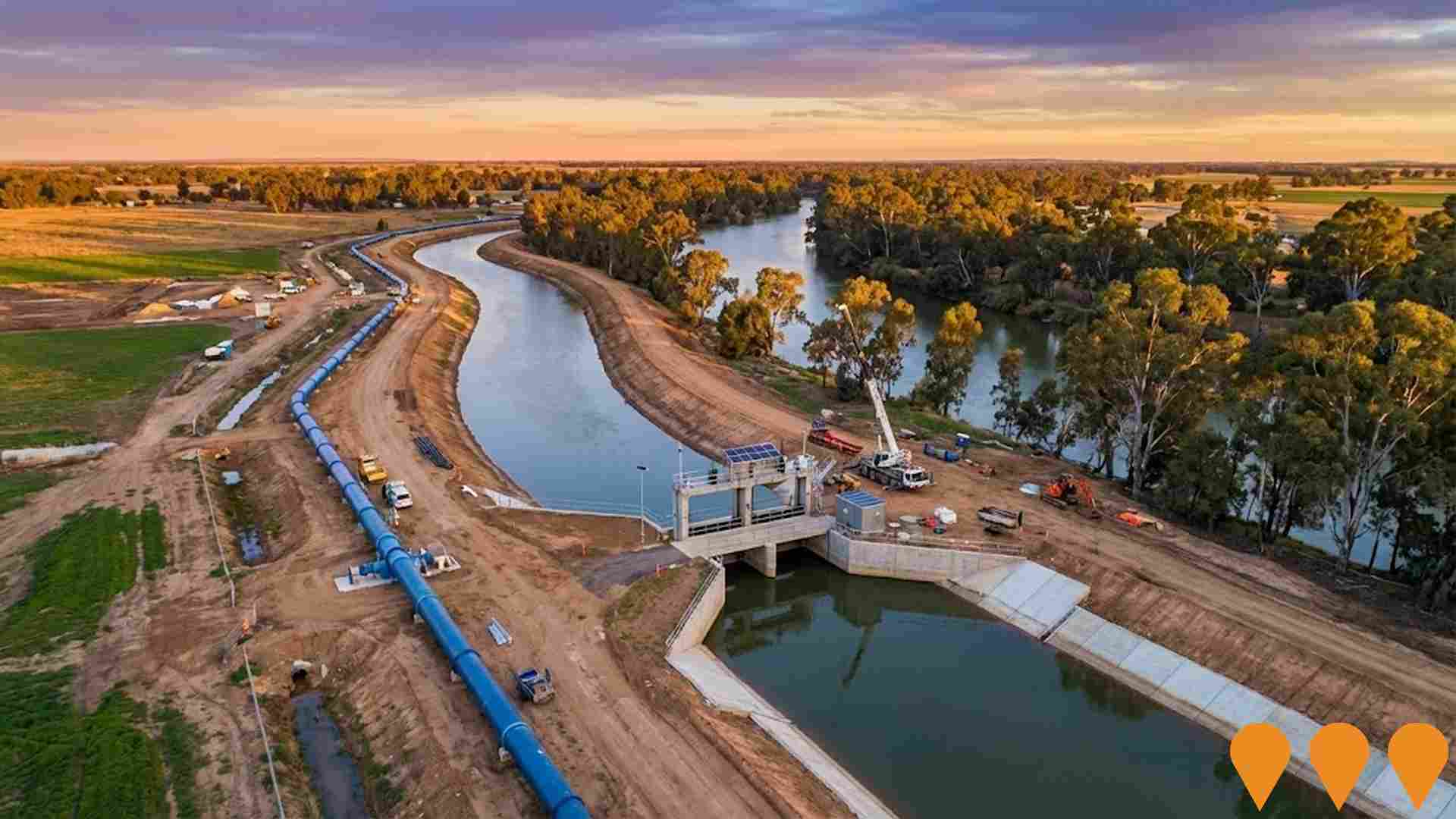
Hay Structure Plan
Strategic land use framework adopted by Hay Shire Council to implement the Hay Local Strategic Planning Statement (LSPS). It guides residential, rural residential and industrial development in Hay over a 20 year horizon, including township growth directions, infrastructure sequencing and policy actions.

Employment
The employment landscape in Hay shows performance that lags behind national averages across key labour market indicators
Hay has a balanced workforce comprising white and blue collar jobs with varied sector representation. The unemployment rate was 4.1% as of June 2025, showing an employment growth of 3.6% over the previous year.
In Hay, 1,658 residents were employed while the unemployment rate was 0.4% higher than Rest of NSW's rate of 3.7%. Workforce participation was similar to Rest of NSW at 56.4%. Employment is concentrated in agriculture, forestry & fishing, retail trade, and construction. Hay has a strong specialization in agriculture, forestry & fishing with an employment share 4.7 times the regional level.
Conversely, health care & social assistance employs only 7.9% of local workers, below Rest of NSW's 16.9%. Many residents commute elsewhere for work based on Census working population to local population count. Between June 2024 and June 2025, employment increased by 3.6% while labour force grew by 4.5%, causing unemployment to rise by 0.8 percentage points. This contrasts with Rest of NSW where employment contracted by 0.1%, labour force grew by 0.3%, and unemployment rose by 0.4 percentage points. Jobs and Skills Australia's national employment forecasts from May 2025 indicate that national employment is projected to expand by 6.6% over five years and 13.7% over ten years, with significant variations between industry sectors. Applying these projections to Hay's employment mix suggests local growth of approximately 5.0% over five years and 11.0% over ten years, though this is a simple extrapolation for illustrative purposes only.
Frequently Asked Questions - Employment
Income
Income figures position the area below 75% of locations analysed nationally by AreaSearch
AreaSearch's latest postcode level ATO data for financial year 2022 shows that Hay has a lower median income of $49,311 compared to the national average of $55,183. The average income in Hay is $55,183, while Rest of NSW has a median income of $49,459 and an average income of $62,998. Based on Wage Price Index growth of 12.61% since financial year 2022, the current estimated median income in Hay is approximately $55,529, and the average is $62,142 as of September 2025. Census data indicates that household, family, and personal incomes in Hay fall between the 16th and 29th percentiles nationally. Income analysis reveals that 29.6% of Hay residents (866 people) earn between $1,500 and $2,999, similar to regional levels where 29.9% occupy this bracket. Despite modest housing costs allowing for 91.9% income retention, total disposable income ranks at the 25th percentile nationally.
Frequently Asked Questions - Income
Housing
Hay is characterized by a predominantly suburban housing profile, with above-average rates of outright home ownership
Hay's dwelling structures, as per the latest Census, consisted of 91.6% houses and 8.5% other dwellings (semi-detached, apartments, 'other' dwellings). In comparison, Non-Metro NSW had 92.7% houses and 7.2% other dwellings. Home ownership in Hay was at 47.3%, with mortgaged dwellings at 23.9% and rented ones at 28.8%. The median monthly mortgage repayment in Hay was $894, lower than Non-Metro NSW's average of $1,179. The median weekly rent figure in Hay was recorded at $175, compared to Non-Metro NSW's $200. Nationally, Hay's mortgage repayments were significantly lower than the Australian average of $1,863, and rents were substantially below the national figure of $375.
Frequently Asked Questions - Housing
Household Composition
Hay features high concentrations of lone person households, with a lower-than-average median household size
Family households constitute 64.7% of all households, including 22.1% couples with children, 30.6% couples without children, and 10.5% single parent families. Non-family households account for the remaining 35.3%, with lone person households at 33.7% and group households comprising 2.2%. The median household size is 2.2 people, which is smaller than the Rest of NSW average of 2.4.
Frequently Asked Questions - Households
Local Schools & Education
Hay faces educational challenges, with performance metrics placing it in the bottom quartile of areas assessed nationally
The area's university qualification rate is 12.0%, significantly lower than the NSW average of 32.2%. Bachelor degrees are the most common at 9.0%, followed by graduate diplomas (1.7%) and postgraduate qualifications (1.3%). Vocational credentials are prevalent, with 38.9% of residents aged 15+ holding them, including advanced diplomas (9.4%) and certificates (29.5%). Educational participation is high at 28.6%, comprising primary education (11.8%), secondary education (7.9%), and tertiary education (1.6%).
Hay's four schools have a combined enrollment of 385 students. Education provision is balanced with three primary schools and one secondary school serving distinct age groups.
Frequently Asked Questions - Education
Schools Detail
Nearby Services & Amenities
Transport
Transport servicing is very low compared to other areas nationally based on assessment of service frequency, route connectivity and accessibility
Transport analysis shows 16 operational stops in Hay, offering a mix of train and bus services. These stops are served by 8 distinct routes, collectively facilitating 74 weekly passenger trips. Transport accessibility is deemed limited, with residents generally situated 1749 meters from the nearest stop.
Service frequency averages 10 trips daily across all routes, equating to roughly 4 weekly trips per individual stop.
Frequently Asked Questions - Transport
Transport Stops Detail
Health
Health performance in Hay is well below average with prevalence of common health conditions notable across both younger and older age cohorts
Health data shows significant challenges in Hay. Common health conditions are prevalent among both younger and older age groups.
Private health cover is low, with approximately 48% coverage (~1,392 people), compared to the national average of 55.3%. The most common conditions are asthma (10.3%) and arthritis (9.8%). 61.3% of residents report no medical ailments, compared to 65.8% in Rest of NSW. Hay has a higher proportion of residents aged 65 and over at 26.8% (784 people), compared to 22.9% in Rest of NSW.
Frequently Asked Questions - Health
Cultural Diversity
Hay is considerably less culturally diverse than average when assessed alongside AreaSearch's national rankings for language and cultural background related metrics
Hay's cultural diversity was below average, with 84.7% of its population being citizens, 92.2% born in Australia, and 95.4% speaking English only at home. Christianity was the main religion in Hay, comprising 69.7% of people, compared to 57.0% across Rest of NSW. The top three ancestry groups were Australian (33.9%), English (32.8%), and Irish (8.2%).
Notably, Australian Aboriginal representation was higher at 6.3%, Maori at 0.5%, and Scottish at 7.7%.
Frequently Asked Questions - Diversity
Age
Hay hosts an older demographic, ranking in the top quartile nationwide
Hay's median age is 48 years, which is notably older than Rest of NSW's median age of 43 years and significantly higher than the Australian median age of 38 years. The age profile shows that the 55-64 year-olds are particularly prominent at 17.1%, while the 35-44 year-old group is comparatively smaller at 8.7% compared to Rest of NSW's population. This concentration of 55-64 year-olds is well above the national average of 11.2%. Post-2021 Census data shows that the 65 to 74 age group has grown from 11.5% to 13.6% of the population, while the 85+ cohort increased from 3.1% to 4.2%. Conversely, the 45 to 54 year-old cohort has declined from 11.6% to 10.2%, and the 55 to 64 year-old group dropped from 18.2% to 17.1%. Demographic modeling suggests that Hay's age profile will evolve significantly by 2041. The 75 to 84 age cohort is projected to grow steadily, expanding by 53 people (20%) from 263 to 317. Senior residents aged 65 and above will drive 100% of population growth, underscoring demographic aging trends. Meanwhile, both the 65-74 year-old and 45-54 year-old age groups are expected to see reduced numbers.



